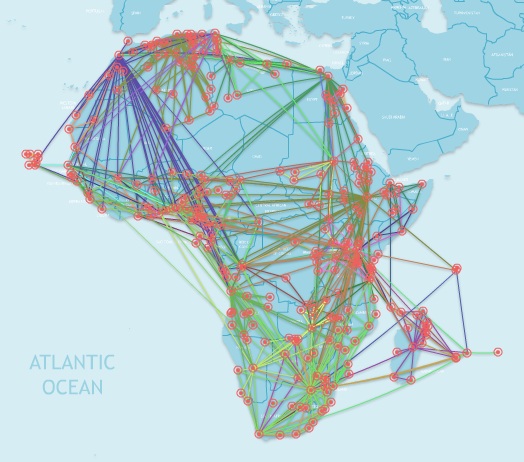Africa has always been the smallest of the world regions in terms of aviation - partly because of the level of economic development, and partly because routes to Africa were traditionally dominated by foreign airlines. There was little intra-African traffic. Indeed to travel from, for example Nairobi to Dakar, it used to be easier to fly via Europe, as intra-African flights were few and far between.
In 1994 there were 1,088 routes flown within Africa. By May 2013 this has had actually gone down to 719. Clearly, there has been a lot of consolidation on the African route network, as low-frequency, small aircraft routes have been abandoned. In 1994 on average a route served only every other day, with an average capacity of 91 seats per flight. Today the average frequency has gone up to 1.3 flights per day and 103 seats per aircraft. In the process the total number of seats offered on intra-African routes has more than doubled from 35.4 million on 1994 to 71.8 million in 2012 - an average annual increase of 4.0%.
Intra-African route network |
|---|
 |
Source: Innovata Flightmaps Analytics |
Despite the market concentration by the five major airlines, the number of African airlines has increased. There are now 70 African-based carriers operating scheduled services to, from or within Africa - more than double the number in 1994. Most of the new airlines are locally established and funded, and many face an uncertain future despite the momentum of economic growth. Some, such as Air Arabia's ventures in Morocco and Egypt and Fastjet are at least partly funded from outside Africa.
While the low-cost carrier model might in theory be thought ideal for the African growth environment, local market characteristics, political and regulatory intervention and external competition have all presented formidable challenges for new operators of this model. As an example Atlas Blue, a low cost subsidiary of Royal Air Maroc, set up to compete with the European no-frills operators, failed to achieve the expected cost savings, and was folded back into its parent airline in 2009. European charter airlines have long served the tourist markets of northern Africa, but in recent years they have been joined by the European based low-cost airlines, notably Morocco and Egypt.
Morocco is a particularly interesting example. It has recognised the importance of air lift for its tourism industry, which in itself accounts for around 10% of its GDP. The aviation market between Morocco and Europe was previously governed by restrictive bilaterals, constraining the potential for growth. Average annual growth of passenger traffic in period 1994-2005 was 2.3%. Then in 2006 the European Union and Morocco signed a wide-ranging Open Skies agreement, removing all capacity restrictions. In the five years since, annual growth has risen to 8.0%. It is only with the recent economic downturn and the effects of the Arab Spring which have seen the growth levels recede.
At the other end of the continent, Kulula and Mango Airlines have carved out a niche for themselves in South Africa. Contrary to the experiences in Europe and North America, where low-cost operators started or owned by mainline airline have struggled, both airlines have long-established operators behind them. Comair set up Kulula in August 2001 as the first South African low cost carrier. It now runs 14 Boeing 737s and transports 2.8 million passengers per year. South African flag carrier SAA set up Mango in October 2006, and latest figures show that the airline carried 1.8 million passengers per year. However, the third South African budget unit, the independently owned 1time ceased operations in November 2012 after eight years. The three airlines combined (including the BA franchise operations) had around 55% of the domestic market in 2012.
As in the rest of the world, the Middle Eastern 'Big three' have expanded rapidly in Africa. Emirates was the first on the scene opening a route between Dubai and Cairo in 1986, but it took until 1995 to expand onto routes to Nairobi and Johannesburg. It has not looked back since and now operates 19 routes into Africa and has become the largest foreign operator into the continent. Qatar Airways also started with Cairo, and while smaller than its Dubai rival, now operates to 13 destinations. Etihad follows behind with eight destinations from Abu Dhabi.
Part of the traffic carried by these Middle Eastern airlines no doubt travels onwards to China, as the tremendous economic growth there has helped fuel its commercial relations with the African countries. China has become Africa's main trading partner. It has only been in recent years that direct flights to China were started. Until Air Algerie started services to Beijing in 2008 there were only services to Hong Kong. Air Algerie has since been joined by seven other African airlines operating services from their respective home bases to Beijing, Shanghai, Guangzhou or Hangzhou. But surprisingly no Chinese airline currently operates services to Africa.
Ethiopian Airlines is by far the largest operator on the Sino-African routes with 79 flights per week to Beijing, Guangzhou and Hangzhou (via a stop in Delhi). Ethiopian, together with Egyptair and Kenya Airways account for just over three quarters of all flights between China and Africa.
With long distances between cities and poor ground infrastructure, Africa needs aviation as a key ingredient of its economic growth plans. Political and economic instability have kept it behind other continents in developing the necessary infrastructure and services. However this decade has seen many positive aviation developments both within Africa and between Africa and other continents. There is still a long way to go, and as in the past, progress seems likely to be two steps forward and sometimes one step back. But for a hopeful sign look no further than trying to fly today between Nairobi and Dakar? Kenya Airways now operates the route - with a stop in Accra.
About the author: Henk Omblet is an analyst at Flightglobal advisory service Ascend
Source: Air Transport Intelligence news























